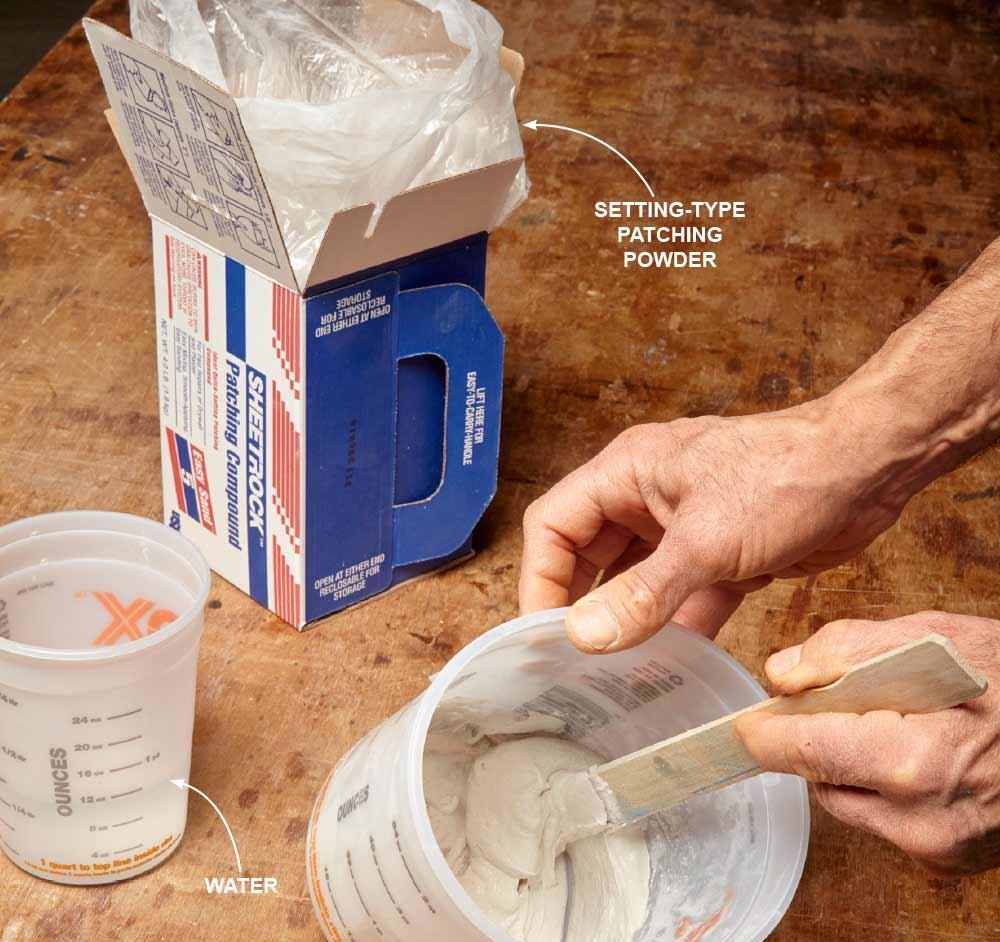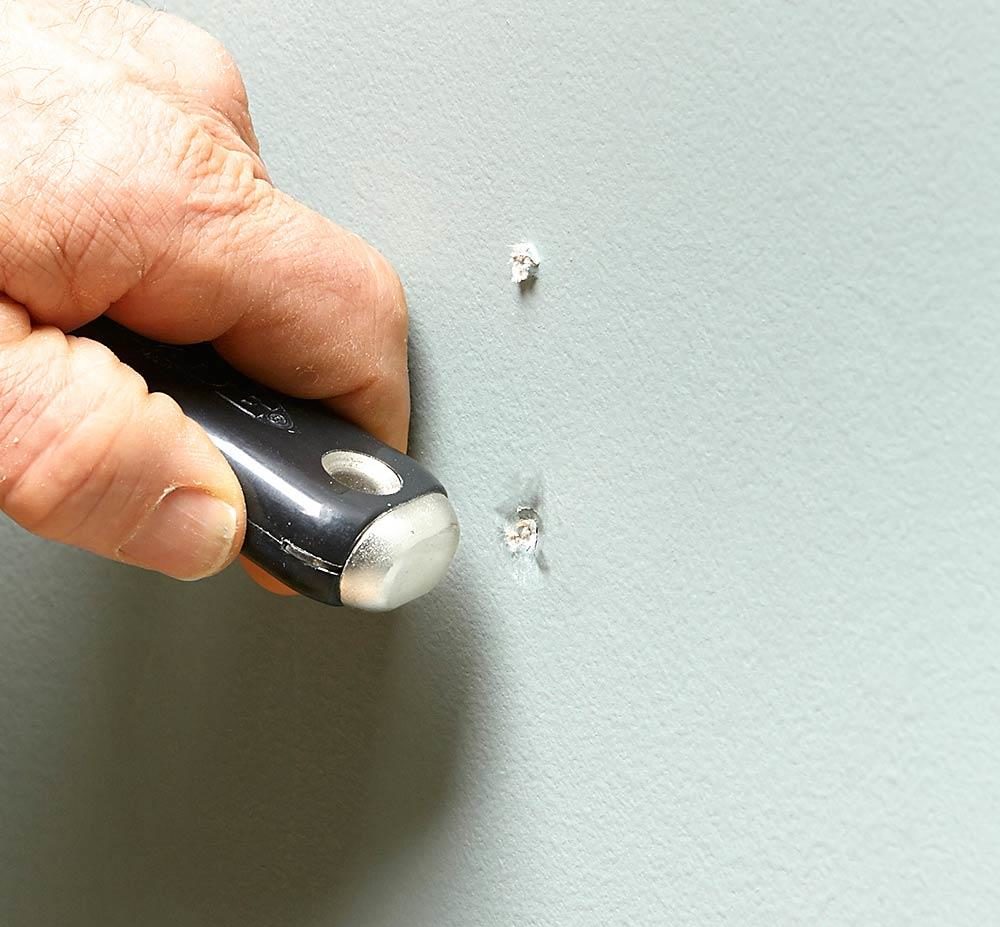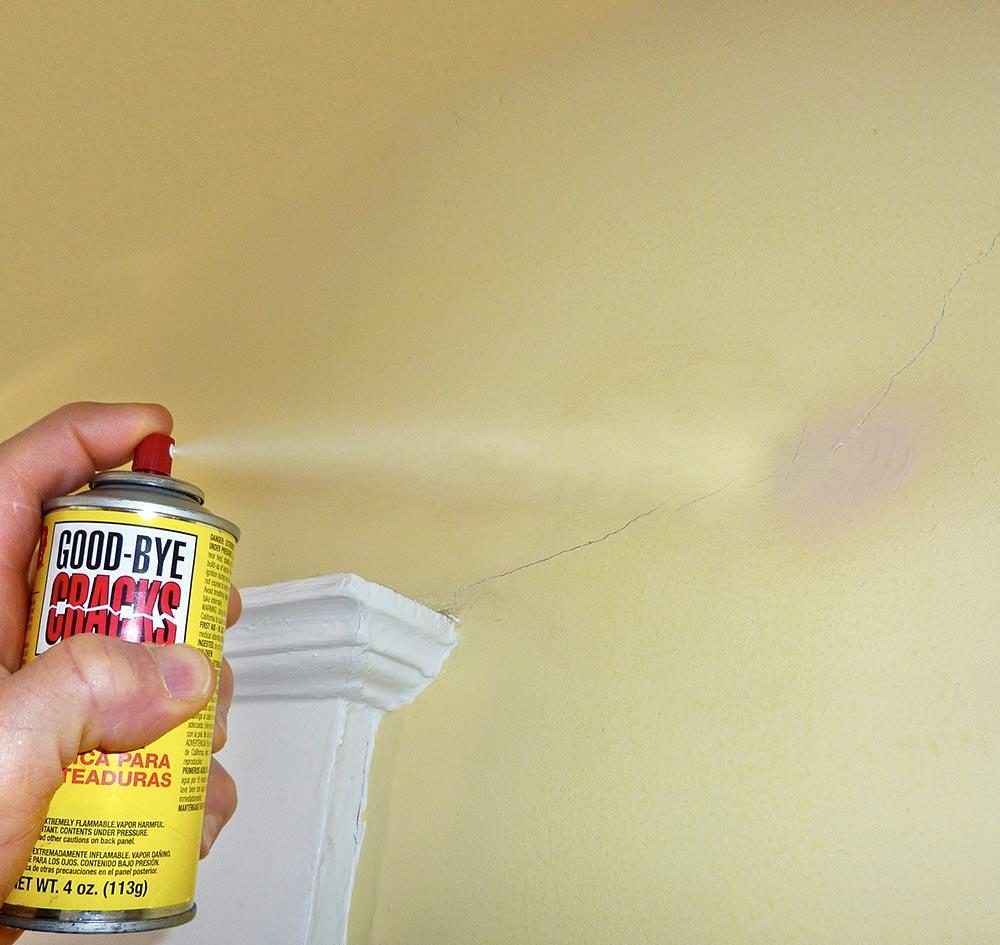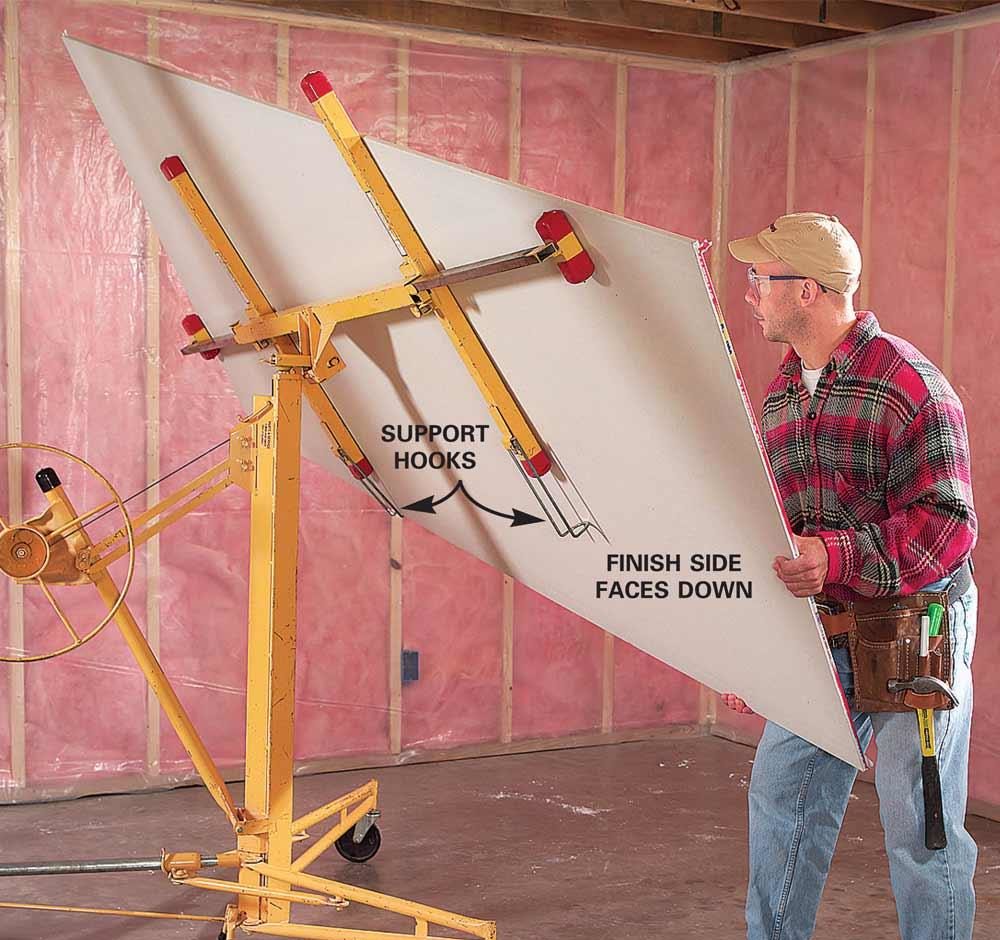Tips for Working with Drywall
We’ve hung and patched and primed and finished our fair share of drywall. Check out this compilation of tips for working with drywall to make your next build or repair easier
Use Setting Compound for Big Holes
It’s fine to fill screw holes and other small wall dings with patching compound, but for dime-size and larger drywall repairs, and for holes that are deep, it’s best to use a joint compound that sets up by a chemical reaction. These are available in powder form with setting times ranging from five to 90 minutes. The reaction starts when you mix in the water, and the compound hardens in the specified time. The five-minute version is nice because you can buy the powder in a convenient 5-lb. box, and the compound hardens quickly, so you can apply another coat right away. Remember, setting-type compounds are harder to sand than regular patching materials, so make sure to strike them off flush to the surface when you fill the hole. You’ll find setting-type compounds wherever drywall taping supplies are sold.
Make a Dent for the Patching Compound
When you remove a nail, drywall anchor or picture hanger, there is usually a little ridge of old paint or drywall sticking out that’s hard to cover with patching material. The solution is to make a dent over the hole, and then fill the dent. Most good-quality putty knives have a rounded hard plastic or brass end on the handle that works perfectly for making the dent. The rounded end of a screwdriver handle or the handle of a utility knife will also work. Press the handle against the hole and twist it slightly while applying pressure to dent the surface, or if you have good aim, use your denting tool like a hammer
Cover Cracks with Repair Spray
Stress cracks usually show up around window and door openings. The cracks are the result of framing movement and are hard to fix permanently. But using spray-on crack repair is a good way to at least extend the life of your repair. The spray forms a flexible membrane over the crack that can stretch and relax as the building moves.
Rent a Drywall Lift for Ceiling Work
If you have to drywall a ceiling, don’t hesitate to rent a lift. It’s well worth the daily rental fee and is by far the best way to get a ceiling up without back strain. Drywall lifts break down into three parts and fit easily into a midsize car. After you reassemble it, release the catch on the wheel and crank it up and down a few times to make sure it’s working smoothly. Then lock the lift and hoist one end of the drywall sheet up to the support hook—finish side down. Now lift the other end of the sheet up and slide it onto the second hook as shown. Lift slowly and smoothly—abrupt or jerky handling can pop the front edge of the drywall off the hook.

Tips for Patching Drywall
Before you paint a wall you have to prepare the surface, which inevitably involves patching. It’s one of the most important steps. But sometimes it takes more than just a can of spackling and a small putty knife to get good results. Here are some wall patching tips and products that will help you speed up the job, avoid problems and end up with a flawless wall.
Use Self-Priming Filler
Patches made with traditional patching materials need to be primed with a sealing-type primer before painting. Otherwise the patched areas could show through the finished paint job as foggy spots. But if you patch with a self-priming patching material, you can avoid this extra step. There are several brands; just look for the words ‘self-priming’ or ‘with primer’ on the container.
Use Setting Compound for Big Holes
It’s fine to fill screw holes and other small wall dings with patching compound, but for dime-size and larger drywall repairs, and for holes that are deep, it’s best to use a joint compound that sets up by a chemical reaction. These are available in powder form with setting times ranging from five to 90 minutes. The reaction starts when you mix in the water, and the compound hardens in the specified time. The five-minute version is nice because you can buy the powder in a convenient 5-lb. box, and the compound hardens quickly, so you can apply another coat right away. Remember, setting-type compounds are harder to sand than regular patching materials, so make sure to strike them off flush to the surface when you fill the hole. You’ll find setting-type compounds wherever drywall taping supplies are sold
Make a Dent for the Patching Compound
When you remove a nail, drywall anchor or picture hanger, there is usually a little ridge of old paint or drywall sticking out that’s hard to cover with patching material. The solution is to make a dent over the hole, and then fill the dent. Most good-quality putty knives have a rounded hard plastic or brass end on the handle that works perfectly for making the dent. The rounded end of a screwdriver handle or the handle of a utility knife will also work. Press the handle against the hole and twist it slightly while applying pressure to dent the surface, or if you have good aim, use your denting tool like a hammer
Cover Cracks with Repair Spray
Stress cracks usually show up around window and door openings. The cracks are the result of framing movement and are hard to fix permanently. But using spray-on crack repair is a good way to at least extend the life of your repair. The spray forms a flexible membrane over the crack that can stretch and relax as the building moves.

Tips for Hiring a Drywall Contractor
Drywall is paneling used to make interior walls and ceilings. When done right it looks smooth, like one surface, rather than all the individual panels. That’s why it’s important to hire the best drywall contractor for the job, which sometimes isn’t the cheapest. However, if the wall is warped or it’s easy to see the panels, then you won’t be as happy with the result. Here’s a list of tips to help you hire the right drywall contractor for the job
Looking for a Drywall Contractor
You know you need a good drywall contractor, but starting the search can be difficult. A good way to start is through referrals. Asking friends, partners, or contacting the AWCI (Association of the Wall and Ceiling Industry) can give you a good place to start. Another way to search for businesses is on the internet. There you can request quotes and look at reviews and photos and ask for referrals. Once you’ve narrowed down who you’re interested in, you can start interviewing potential drywall contractors.
Interviewing Drywall Contractors
It’s important to ask the right questions of anyone who might do work for you. Questions shouldn’t just be how much they think the job will cost, ask questions about the company. Questions about the age of the company and the company history are relevant to any work you will have done. If the company has a recent bankruptcy, then you need assurances that the job can be completed. You should know what licensing they have if they have insurance, who pulls permits, and how they resolve disputes. These questions give you a view of the legitimacy of the drywall contractor. These questions let you know about the business, but you also need to know about the job and how they operate
Contract Negotiation
Once you’ve decided which drywall contractor to hire it’s time to negotiate a contract. It’s important to have a couple of things in the contract. The first is to have the estimate or actual price in the contract with clear language as to which it is. If possible get an itemized estimate or actual price at the time of signing. This lets you know exactly why you’re being charged and what you’re being charged. And if the price changes over time, you can see where it changed and why
These tips and questions will prepare you for hiring a drywall contractor, that way you hire the best company for the job. It’s important to remember that the cheapest bidder might not be the best company for the job. Because drywall is one of those elements that everyone notices if it’s not done well. And it’s worth having the job done right the first time.

Tips For Hiring a Drywall Contractor
Like painting, drywalling is a very labor-intensive technique. In addition the drywall installer and taper has to be skilled because any imperfections will be picked up long after the painters have left. This is why a great emphasis should be placed on hiring the right drywall contractor for the job.
Drywalling is actually two separate jobs. The first part is the sheetrock installation which entails cutting, shaping, putting the panels into place and then fastening them. The second part includes taping the seams and then sealing both these and the screw heads with drywall compound. This latter process revolves around coating and sanding these surfaces until the walls and corners are smooth and you can’t tell where one sheet begins and the other ends
Preparation
If you take a look at a finished wall in any home it looks like a seamless flow of color which is only interrupted by the corners. And these looked like they have been hewed from a single block with a precision saw blade. Only your previous knowledge of building will tell you differently. However, the drywall job is only as good as the framework to which it is fastened
Hiring the Drywall Contractor
As nothing is more infuriating to a homeowner than to see bulges and rifts on a finished wall you can’t hire just anyone to drywall your home. There are ways to find out the ones who will do the best job. A drywalling company can cost in the realm of $25 to $45 per hour per person for sheetrock installation and drywall taping so they are not cheap. This is why you have to follow a few guidelines
Finding a Contractor
This can be accomplished through a variety of places like the internet, home building stores and word-of-mouth. Usually home building places are good because they know the credit history of all the contractors and can give you an idea of who is trustworthy. Web sites like HandyAmerican.com can provide you with detailed information about contractors rated and reviewed by your neighbors

How to Repair Drywall
Drywall is relatively simple to install and easy to repair. It’s also easy to repair badly, which can leave a lumpy mess that declares “shoddy” to anyone who enters the room.
It’s best to do a repair with three or four thin coats of compound–if possible leaving sanding for just the last coat. Also, “the most important thing with a repair is to build the joint out wider than you would normally,” says drywall contractor Rick Schwartz, who serves as secretary treasurer of Marietta Drywall in Marietta, Ga. The key is to leave a wide and very shallow slope on all sides, he says.
A drywall repair toolkit is simple. It consists of flexible knives in 3-, 6- and 8-in. widths, an inside-corner knife, a utility knife, a hammer, a screwdriver, a drywall saw and a drill. Some repairs also may require a hand sander, a hacksaw, a nail bar and a level. Chances are good that you already own these. As for materials, drywall compound, mesh tape, paper tape, drywall nails and screws take care of most repairs
Watch The Weight
If you have several large repairs to do and you’ll be buying a sheet or two of drywall, be advised that a sheet of regular 1/2-in. drywall weighs about 1.7 pounds per square foot. That means a 1/2-in. 4 x 8-ft. sheet weighs a bit more than 54 pounds (a 3/8-in. sheet weighs almost 45 pounds). If you stand it on edge and it falls over, someone–especially a child–could get hurt.
Beware Of BucketsFive-gal. compound buckets pose a drowning or suffocation hazard to small children–when they are new and filled with compound, or later after they are cleaned and used for car washing and other jobs
